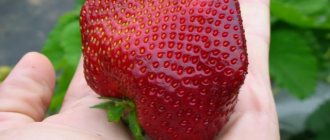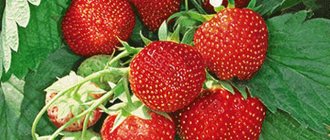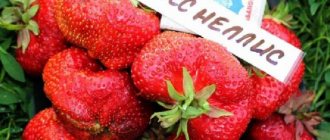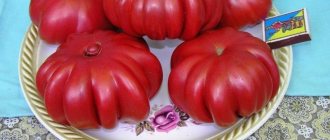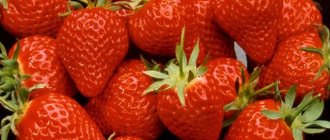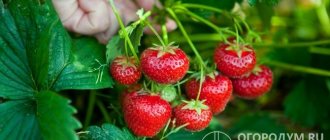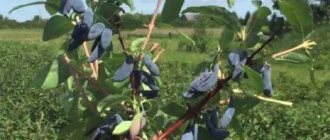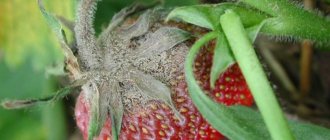Strawberry Mashenka was bred in the middle of the last century by Soviet breeders and is better known under another name - Moscow Jubilee.
For many decades, the variety occupied a place of honor in the gardens of Soviet gardeners, then it was supplanted by advertised foreign novelties and was undeservedly forgotten. Today, Mashenka’s popularity is returning and it is compared with the best expensive Dutch varieties of strawberries. A detailed comparative analysis revealed that our domestic strawberries are no worse in terms of taste characteristics, and in terms of compliance with the climatic conditions of Russia, they are significantly superior to their foreign counterparts.
Description of the variety
Mashenka is a mid-early crop characterized by extended fruiting. In the southern regions of Russia, this strawberry shows signs of remontancy and produces a second wave of harvest.
Bushes
The Moscow Jubilee bushes are compact, medium spreading, very tall (up to 45 cm in height). The corrugated leaves are large, amber-green in color and look beautiful and powerful on strong shoots.
There are a lot of flower stalks, each can produce up to 6 large fruits. The flower stalks are thick and strong, but the weight of the large berries causes them to fall to the ground. Sepals are openwork, large.
Berries
The burgundy-scarlet berries of the first and subsequent waves differ. The first berries have an almost round, slightly flattened shape, similar to a cockscomb. Such a fruit is obtained as a result of the fusion of several closely spaced flowers (flowers are fused by receptacles). One such mutant berry can weigh up to 120 g. The structure of the fruit is dense, juicy, without voids. The taste is very pleasant, sweet, with a slight sourness. The aroma and aftertaste of Mashenka transports you to a forest strawberry meadow.
The berries of the next harvest wave are already of the correct conical shape with a rounded tip. The weight is significantly reduced, but the taste remains consistently excellent.
One of the ways to “force” Moscow Yubileiny to bear fruit 2 times: after the first fruiting, mow the bushes, let them dry (do not water, only precipitation), then water them abundantly and it will bloom again.
Productivity
The yield of Mashenka strawberries is not the highest, but not the lowest either - on average 800 g per bush. With proper care, gardeners in the southern regions receive two harvests per season. Mashenka has been actively bearing fruit for 4 years. Then the plantation is renewed.
Sweet strawberries: 5 best varieties for the Moscow region
Kimberly
After waiting for the strawberries of the mid-early Kimberly variety to fully ripen, you can enjoy the sweet fruits. It should be noted that they taste sweet, but not cloying.
Other benefits of Kimberly:
- powerful bushes, from each of which you can collect from one to two kilograms of berries;
- the conical shape of the fruit has no voids in the pulp;
- frost and drought resistance;
- the weight of each berry can reach 50 g (average weight 30-40 g);
- fruiting lasts about three weeks;
- average resistance to strawberry diseases;
- Over the summer, a few mustaches form.
Kimberly sweet strawberries are excellent for growing in the midlands. In colder regions, bushes may freeze in winter.
Vima Zanta
Already at the beginning of summer in the Moscow region you can enjoy sweet strawberries of the Vima Zanta variety.
Varietal advantages of "Vima Zanta":
- early ripening;
- fairly large fruits weighing 30-50 g;
- sweet round berries with a slight sourness, which when ripe acquire a light red color;
- high yield (up to 1.1 kg per bush);
- tolerates frost and drought well;
- resistance to powdery mildew.
The Vima Zanta variety has very few disadvantages. This is a high formative ability and loose fruits, inside of which there may be voids. At the same time, the whiskers can be easily removed, and the berries, although loose, are very juicy.
Queen Elizabeth
The Queen Elizabeth variety of strawberries with sweet berries is very popular among gardeners. It could easily be added to the section describing large-fruited strawberries, since the weight of the fruits can reach 65-100 g. They have a honey aroma and a cone-shaped shape.
You will be interested to know: Eggplants for Siberia, early and mid-season best varieties, sowing dates
Advantages of the variety:
- high yields (about 1.5 kg per bush) are achieved in the Moscow region, Siberia, and the Urals;
- bears fruit in waves several times per season;
- The first harvest can be harvested at the beginning of summer;
- stores well, does not become soggy after defrosting, and retains the shape of the fruit in jam;
- Withstands frosty winters without problems.
You can’t do without disadvantages, of which “Queen Elizabeth” has very few:
- The need to renew plants every two years, as they grow.
- During the rainy season, the berries become watery.
- Does not tolerate elevated temperatures well.
Zenga Zengana
Many summer residents grow strawberries on their plots with sweet fruits and a nutmeg aroma of the Zenga Zengana variety. It is suitable for open ground in Central Russia, as it is resistant to prolonged rainfall and many strawberry diseases.
Other advantages of the Zenga Zengana variety:
- high yield (up to one and a half kilograms per plant);
- long-term fruiting (can produce a harvest until September);
- does not require a specific type of soil;
- after defrosting and cooking, the fruits retain their shape;
- The beautiful dark red berries have a glossy sheen.
When harvesting, you should know that the berries must be collected together with the stalk, as they do not come off easily.
Disadvantages of Zeng Zengan:
- A large formation of mustaches that constantly have to be torn off.
- By the end of the season it becomes smaller, while at the beginning of fruiting the fruit weighs up to 40 g.
- The best taste is in the second year after planting.
Strawberries Zenga Zengana can easily be classified as varieties resistant to many diseases. Under unfavorable conditions, it can be affected by spider mites, leaf spot and gray rot.
Sudarushka
At the end of May, summer residents of the Moscow region begin to collect sweet strawberries of the Sudarushka variety. Small fruits (12-35 g) have a strawberry aroma that will not leave strawberry lovers indifferent.
Advantages of the Sudarushka variety:
- when grown in greenhouses and greenhouses, the crop can be harvested in early spring;
- tall bushes with high yield (up to 2 kg each per season);
- long-term storage;
- very resistant to strawberry diseases;
- not afraid of frost, drought and prolonged rains.
The disadvantages of the Sudarushka strawberry are a lot of whiskers and the possibility of pest damage.
a brief description of
Modern breeders use the Mashenka varietal crop to breed hybrid varieties. They take the best that this variety has: large fruits, ease of care.
Advantages of the variety
- low requirements for growing conditions;
- large juicy fruits;
- good shelf life and transportability of the crop;
- high productivity;
- excellent taste;
- resistance to most diseases and major pests;
- winter hardiness and frost resistance;
- powerful, tall bushes;
- the possibility of obtaining two harvests per season (in the south and in the greenhouse);
- easily propagated by whiskers.
Gardeners also note the versatility of using fruits. Mashenka strawberries are good fresh, in compotes and jam.
Disadvantages of the variety
- yield decreases as temperature decreases;
- leaves and fruits get burned from hot sunlight, shading is required;
- with heavy rain and high humidity, the fruits lose their quality;
- Due to the unevenness of the fruits, the variety is not suitable for farm cultivation.
Gardeners forgive Mashenka these shortcomings because of her excellent taste and aroma.
Advantages and disadvantages
This variety has earned only positive reviews from gardeners and popularity in markets and gardens.
Strawberry Masha has a number of advantages for which it is so popular among gardeners and hobbyists:
- Taste qualities;
- Appearance;
- Disease resistance;
- Large berries;
- High commercial properties.
Disadvantages include sensitivity to low temperatures, which freeze the plant, and to long exposure to the scorching rays of the sun, which burns the foliage. But with proper care, you can avoid unpleasant consequences from cold weather or scorching sun. The berries need to be covered at night when there is a threat of a drop in temperature and light shade should be provided in the scorching sun.
Due to the taste and size of the berries, this variety is confused with the anniversary strawberry Govorova. But Govorova’s strawberry, although similar to Mashenka, was bred much later.
Mashenka's strawberry fully corresponds to the description on the package, produces the same juicy and sweet large berries as in the picture of the seed packet. With proper care and good weather conditions, the crop can be harvested twice.
Landing
It is best to plant seedlings of the Mashenka variety in the spring. Already this season the plant will give its first harvest of the largest berries. It is better not to plant a plantation in late autumn, because young strawberries will not have enough time to take root before the cold weather. The planting deadline is at least a month before the first frost.
In the south of Russia, strawberries are planted in early April. From the end of April, plantings begin in central Russia and in the Moscow region. Mid-May and early June are the best times for planting in the Urals and Siberia. By this time the air should warm up to + 10 ℃.
It is optimal to plant strawberries in late July - early August so that the seedlings develop well and bear fruit abundantly for the next season.
On the site, choose a place slightly protected from sunlight. The soil structure should be loose and fertile. Add humus (a bucket per m2), superphosphate (100 g/m2), and potassium sulfate (120 g/m2) to the beds. Clay soil is loosened with sand (0.5 buckets per m2), acidic soil is neutralized with dolomite flour or ash.
The most popular planting scheme is in rows. Leave 30 cm between bushes, 50 cm between ribbons. The beds, for better sun exposure, are located from north to south.
First, the holes must be shed with warm water and only then the seedlings should be placed in them, straightening the roots. The growing point should be located at ground level, not covered with soil. The seedlings are watered with warm water and the plantings are mulched with sawdust, peat or pine needles. It must be remembered that organic mulch at the beginning of overheating binds soil nitrogen. To prevent plants from getting sick from a lack of nitrogen, it is advisable to spill the mulch with a solution of mullein (1:10), chicken droppings (1:20).
Harvesting
Garden strawberry Mashenka is a mid-early variety; the harvest can be harvested already in the second ten days of June, provided it is grown in a warm climate. For residents of the middle zone, the Moscow region, the Urals and Siberia, the fruiting period shifts slightly - to approximately July.
The berries ripen evenly, therefore, the harvesting process will not be drawn out. Ripe fruits must be collected 3 days after full ripening.
The dense structure allows strawberries to be transported over long distances without loss of integrity and presentation.
Strawberry Mashenka is not a remontant variety, but it can be forced to produce a second wave of harvest. To do this, after picking the berries, you need to mow the green mass at the root and do not water for 30 days. After a month, strawberry seedlings will need to be filled with 2 buckets of water per 1 m2 every day, after which Mashenka begins to bloom again.
We suggest you read: How to kill bed bugs and their eggs
Mashenka’s strawberries are ripening quickly, and given their early ripening, by the end of June almost the entire harvest has already been harvested. The berries are collected after 3-4 days; it is better to remove them with the stem to preserve the juice.
When placing berries in containers, take into account that large fruits will suppress smaller ones. Therefore, if you have to transport crops from a suburban area, choose low, wide containers for transportation.
Growing and care
Mashenka strawberries are grown in open ground and in a greenhouse. There is nothing complicated in matters of planting and care; the main thing is to water them on time and shade the bushes from hot rays.
Watering
Young bushes need frequent watering, at least once every 3-4 days. It is advisable to carry out the procedure in the morning.
Adult bushes are watered depending on weather conditions, avoiding drying out of the soil and excessive waterlogging. The best method is drip irrigation.
Experienced gardeners recommend covering strawberries with film during rainy summers to prevent the quality of the fruit from deteriorating and gray rot from developing.
Loosening and killing weeds
At the time when the Moscow Yubileinaya was just bred, Soviet gardeners did not yet have effective synthetic mulching materials. One of the labor-intensive agricultural techniques was loosening the soil around the bushes. Today it is possible to avoid this tedious procedure if you cover the strawberry bed with black spunbond. Non-woven material not only retains moisture and prevents the growth of weeds, but also protects the fruits lying on the garden bed from rot. An alternative inexpensive mulch material is regular straw or sawdust.
Removing a mustache
Strawberries of the Mashenka variety have average growth. If you do not plan to leave rosettes for reproduction, then the whiskers must be trimmed during the season at least once every 1-2 weeks.
Top dressing
Fertilizers applied during planting will last for a year. Next spring, nitroammophoska is applied under the bushes. Prepare a solution at the rate of 25 g of product per 10 liters. water. Water at the root, spending 1.5 liters. solution for each plant.
During the period of the ovary of the first fruits, the plant is fed with organic matter. Mullein is bred in a ratio of 1:10, bird droppings 1:20.
The use of herbal infusion shows good results. To prepare it, any container is filled ½ with grass and filled with water. After 10-14 days, the fertilizer is ready. The grass is squeezed out, the solution is diluted with water in a ratio of 1:3 and applied under the root. The squeezed grass will serve as a good mulch, because... has begun to rot and will not bind soil nitrogen.
At the end of fruiting, the plants are restored to strength with potassium and phosphorus fertilizers. Potassium nitrate will need 20 g per bucket, and about the same amount of superphosphate. You can replace store-bought fertilizers with wood ash at the rate of 150 g per bucket of water.
Pest and disease control
Strawberry variety Mashenka can suffer from powdery mildew and nematodes. A remedy that has been proven over the years is 1-2% Bordeaux mixture.
The most common pests that can damage bushes are spider mites and raspberry-strawberry weevils. If they are noticed on a plantation, the insecticides Aktara and Fitoverm will help.
Treatments are carried out early in the morning or in the evening. Strictly adhere to the dosage indicated in the instructions. Strawberries should not be treated with fungicides or insecticides less than a month before harvest.
Preparing for winter
Strawberries Mashenka will withstand temperatures dropping to -16 ℃. In the southern regions the plant is not covered. In the central zone, the Urals and Siberia, bushes must be prepared for wintering. Dry leaves are trimmed without touching the flower stalks, the bushes are hilled up and mulched with peat or sawdust. The top of the plants is covered with spruce branches or non-woven material.
Pests and diseases of strawberries Mashenka
As noted earlier, the variety has a fairly strong immune system. However, if the culture is started and not taken care of, it may encounter a number of the following problems:
- Gray rot. With this disease, a characteristic gray coating begins to appear on the plant. It coats the strawberry fruit, eventually rendering it inedible. The fetus dies. To combat this disease, special fungicides are used.
- White and brown spots. Characteristic symptoms of white spot are reddish spots with white dots on the leaf blades. Brown spotting is marked by the appearance of red-brown spots on leaf blades and drying out of their edges. To treat this disease, special pesticides are also used.
- Powdery mildew. With this disease, a white coating appears on the plant. Special fungicides are also used to solve the problem.
- Nematode. This parasite causes significant damage to the crop. A nematode is a small worm up to 1 mm in size. Parasites feed on the sap of the plant, which is why it begins to wither, stops developing, and loses its immune system. Strawberries affected by nematodes become susceptible to various strawberry diseases. To combat nematodes, special insecticides are used.
- Spider mite. This parasite is identified by the presence of cobwebs on the bush. After spider mite infestation, the leaf blades of the crop begin to turn yellow. To combat this insect, special insecticides are used. Good ones are “Karbofos” and “Fitoverm”.
Reproduction
Strawberries of the Mashenka variety are propagated:
- seeds;
- dividing the root system;
- rooting the mustache.
Propagation by seeds is not a popular method, it is long and labor-intensive. The division of bushes is carried out no earlier than 3-4 years after planting. Choose healthy, disease-free plants. The method is risky, not all rosettes take root, it is not uncommon for one rosette to take root from a bush and it will not be possible to increase the plantation.
The easiest and most effective method of propagation is rooting the mustache. Select the healthiest and largest uterine bushes that produce the largest amount of harvest. For reproduction, rosettes of the first and second order are taken. They are deepened into the ground, the remaining mustaches are cut off.
Seedlings can be separated from the mother bush and planted in a new place when they show the following signs:
- the diameter of the root collar is at least 6 mm;
- developed root system;
- At least 2-3 young leaves have formed.
Young plants are best suited for propagation by mustaches; in subsequent years, the number of mustaches will decrease.
Reviews
I have been growing the “Mashenka” variety for a long time. They do not seek good from good. The strawberries are delicious, aromatic, large, I don’t need anything more. Some berries are so large that they do not fit into a faceted glass.
I grow Clery, Asia, Syria, Moscow Jubilee. The Soviet representative is not suitable for sale - the shape of the berries is clumsy and the size is different, but the taste and aroma are good. None of the varieties spoil the collection.
Strawberries of the Mashenka variety are famous for their ease of care, excellent strawberry taste and aroma. Large berries are easy to pick and transport. This variety is worth giving it a new life. It is much better than many new imported varieties that do not take root well in the difficult climate of most Russian regions.
Recommendations for selecting and preparing soil
The site for planting strawberries should be chosen on a flat area - it can be a hill, but always on level ground.
The best solution is a site located on the western or southwestern side . Not suitable for the Moscow Jubilee Lowland, slopes, swampy areas.
Due to the fact that the variety is extremely sensitive to low temperatures, planting should be done in May or August . It is first necessary to prepare the soil for planting. To do this, fourteen days before the proposed event, the area is treated with insecticides. Loosen the soil, add humus and sand - ten kilograms of humus and five kilograms of sand per square meter of soil, then dig up.
Strawberries are planted in May or August.
